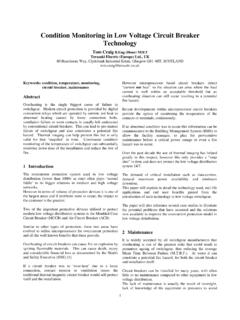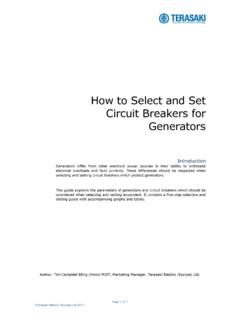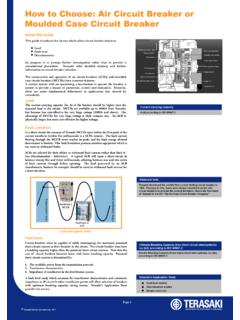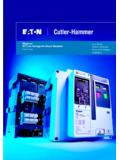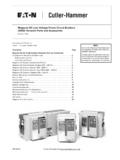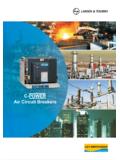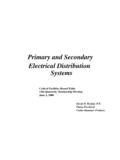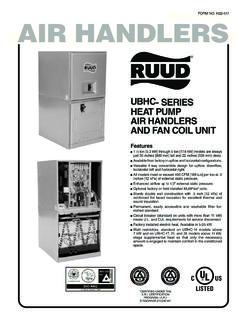Transcription of Retrofitting of Low Voltage Air Circuit Breakers - …
1 DESIGN AND Retrofitting OF LOW Voltage AIR Circuit Breakers . By Peter Anderson Terasaki Electric Europe Ltd, UK 80 Beardmore Way, Clydebank Industrial Estate, Glasgow G81 4HT Abstract Throughout the world there are, many old, low Voltage Circuit Breakers protecting essential industrial processes that have been operational for a significant time period beyond their functional design life. Obtaining spares for obsolete Circuit Breakers of this age can prove to be impossible and replacing the entire switchboard can have a serious impact on production downtime and budget constraints. Retrofitting a modern low Voltage air Circuit breaker has been proven to be a cost and time effective solution to this growing dilemma. 1 Introduction Many of today s industrial low Voltage electrical installation systems, are protected by Circuit Breakers that have been operational for thirty, forty or even fifty years. Any Circuit breaker that has been in service for this time period will either be very close to the end of its useful working life or worst, beyond it.
2 It is important to remember, that low Voltage Circuit Breakers are in fact safety devices. Whilst Circuit Breakers may remain inactive for many years, they may be called into operation at any time, to prevent damage to the installation from various forms of overcurrent. Plant and facilities managers are often faced with the dilemma of keeping planned production downtime to a minimum but ensuring the risk from key components such as a Circuit breaker failing without notice, never ever occurs. Operating any piece of electrical switchgear such as a Circuit breaker until is fails is not an option many facility and plant managers can afford. Rather than replacing the entire low Voltage switchboard which could have severe disruption on operations, several companies are now offering the option to retrofit the Circuit breaker only . This can reduce substantially any down time and can be carried out on a much reduced budget.
3 Installing a new low Voltage Circuit breaker also offers many advantages over their older counterparts. Key benefits are increased lifetime, improved reliability and options for enhances maintenance diagnostics and communication. This paper will focus on the Retrofitting of Air Circuit Breakers (ACB) and demonstrate that it is a cost effective way of increasing plant life with minimum disruption. In doing so it will also highlight the advantages of modern air Circuit breaker technology. 2 Background In the 1950 s many high integrity low Voltage switchboards were fitted with manual dependant operation air Circuit Breakers . The English Electric OB3 (Figure one) being an example of a Circuit breaker of this design. The slow closing of the main contacts of these units meant that interlocking had be designed into the switchboard to inhibit closing direct on to a loaded Circuit . These interlocks have been known to fail with resultant serious injuries to the personnel operating these out dated Circuit Breakers .
4 After a life of 50 to 60 years there are still many of these units in operation today. Figure 1 English Electric OB3 Circuit breaker . In the 1960 s and 70 s, arguably the UK market leader in low Voltage air Circuit Breakers was GEC with their M-Pact range(figure two) complete with CTZ over current relays. These air Circuit Breakers along with others on the market like Ellison s GEA range were an improvement on the manual dependant units but by today s standards were large for their switching capabilities and full of materials like asbestos, cadmium and lead which are banned by present legislation. A disadvantage of this type of 60 s/70 s design Circuit breaker was that the Circuit breaker front panel became the front panel of the switchboard so the ACB became part of the mechanical design and construction of the switchboard, rather than a component within the switchboard.
5 This can become an advantage when designing plug in retrofit solutions. Figure 2 GEC M Pact Circuit breaker . As with the manual dependant operation Circuit Breakers there are tens of thousands of these Circuit Breakers still in operation across the UK. Of course when they fail to trip, overheat or just break down because of their advanced years it can cause major problems for plant managers in the facilities they supply. New replacement Circuit Breakers or parts can not be purchased with probably the only solution being to obtain old second hand units to act as replacements. The popularity of these UK designed Circuit Breakers corresponded with the sixties and seventies North Sea Oil and Gas boom. Petro-Chemical and Process plants were designed and built in locations all over the UK. Many of these plants were designed for a maximum life of 30 years. Today with the price of oil and gas escalating, it is now worth the major oil companies looking at marginal fields to exploit so plans are being put in place to extend the life of many of these power system facilities by another 20 or 30 years.
6 The Circuit Breakers in these plants around the UK are at the end of their functional lives but maintenance engineers because of production cost implications can not get the required time to shutdown plants to replace complete switchboards. 3 Retrofit Solutions When Circuit Breakers of the vintage described above fail, the client has a decision to make as to whether to replace the switchboard, repair the faulty Circuit breaker or to retrofit with new modern Circuit breaker designed for the 21st century. When looked at objectively a switchboard is a metal box containing Circuit Breakers , connected by copper busbars. If the power systems are properly maintained to the required standard, the only part that can fail drastically is the Circuit breaker so the question posed is Why not replace just the Circuit Breakers ? There are a number of small companies who will strip out the Circuit breaker chassis and replace with a modern version by bending coppers to suit the switchboard in the switch room on site.
7 These solutions maybe perfectly acceptable and will probably be able to withstand the potential fault currents, should the switchboard be subject to a short Circuit of the full short time withstand(Icw) rating of the original design. However the question must be posed How do we know that the new copper conductors designed and manufactured on site can withstand these forces? The answer is we don t. The correct solution is to have a retrofit kit designed and engineered by electrical engineers using Computer Aided Design (CAD). The new designed interconnecting coppers should then be proved to withstand short Circuit stresses by computer programme and if necessary the Circuit breaker and new coppers fully tested at an independent test station. Figure 3 Short Circuit calculation for bus bar stresses. A retrofit solution designed in this way would not invalidate any of the original design data of the original switchboard and the client would know that the new design of retrofit Circuit breaker would be safe under all conditions.
8 If a retrofit is carried out and at a later date it does not withstand the short Circuit forces that the power system can deliver to the retrofitted Circuit breaker connections, it can be very expensive in terms of lost production time and even danger to life. This could be the case if all aspects of the design change are not investigated before the Circuit breaker is replaced. Retrofit designs can also be of the plug in type. Terasaki have this type of design for both the Ellison GEA and GEC M Pact air Circuit Breakers . The advantage of the plug in design retrofit kits is that the switchboard need NOT be shutdown and the bus bars dead when the Circuit Breakers are retrofitted. To carry out this style of retrofit which uses the original Circuit breaker chassis and connections, it is advisable to carry out a thermal image survey of the chassis cluster connections. This is to verify that there are no over heating problems at this connection before installing the new Circuit breaker .
9 Some clients prefer to change both the chassis and the body of the Circuit breaker , again this is not a problem, but of course the switchboard must be made dead completely as access to all bus bar and Circuit breaker connections is required, This is not always possible if the switchboard has been designed for front access and is located against the wall of the switch room. Figure 4 Rear connections of GEC M Pact bolt- on type retrofit. The manufacturer and type of Circuit breaker to be used in a retrofit solution should be carefully selected. The main obvious requirement is for the new Circuit breaker to be able to fit in to the space vacated by the defective unit so the more compact the new Circuit breaker is the better. The front to rear termination dimension is critical to enable the new coppers to be formed into the configuration required by the existing bus bars and Circuit breaker to be replaced.
10 4 Circuit breaker Innovations To the benefit of retrofit applications modern ACBs, compared to their predecessors, now occupy considerably less volume. This is derived from the trend of smaller areas being allocated for switchboards and the demand for higher packing densities. To achieve this dramatic reduction in volume, yet increase it s interrupting capacity, and maintain a safe working temperature, requires major innovations in contact technology. The majority of ACBs used are draw-out pattern to provide easier access to the ACB and additional isolation which maintenance procedures may require. This requires the use of isolating contacts for the interconnection between body and chassis. Transferring these isolating contacts from the chassis to the body and directly connecting them to the ACBs fixed contacts, substantially reduces the depth of the ACB. As the name suggests, the interrupting medium of the ACB is air and therefore sufficient space is required between the contacts to ensure effective arc extinction.

